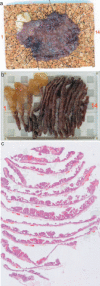Endoscopic Submucosal Dissection (ESD) in Colorectal Tumors
- PMID: 26288580
- PMCID: PMC4513806
- DOI: 10.1159/000358529
Endoscopic Submucosal Dissection (ESD) in Colorectal Tumors
Abstract
Background: Endoscopic submucosal dissection (ESD) - initially developed for the treatment of early gastric cancer in Japan - is an attractive option for en bloc resection of larger sessile or flat colorectal neoplasia.
Methods: A review of the current literature on colorectal ESD was carried out.
Results: In contrast to conventional endoscopic mucosal resection (EMR), ESD for larger colorectal neoplasia yields high en bloc resection rates and very low recurrence rates. The frequency of delayed bleeding is similar for EMR and ESD. Higher perforation rates during ESD are mostly due to microperforations identified and treated during the intervention, and are therefore of minor clinical relevance. A major disadvantage of ESD is the necessity for high-level endoscopic skills and long procedure times. ESD also has the potential to replace laparoscopic surgery or transanal endoscopic microsurgery mainly due to its lower complication rates.
Conclusion: ESD for the resection of larger flat or sessile colorectal lesions has potential advantages over conventional EMR or minimally invasive surgery. Due to the low incidence of early gastric cancer, experience with ESD will remain limited in Western countries. The spread of colorectal ESD will depend on adequate training opportunities and also on modifications yielding a reduction in procedure time.
Hintergrund: Die endoskopische Submukosadissektion (ESD) wurde zur Therapie des Magenfrühkarzinoms in Japan entwickelt. Sie ist auch eine attraktive Methode zur En-bloc-Resektion größerer sessiler oder flacher kolorektaler Adenome.
Methoden: In dieser Übersicht wurde die Literatur zur kolorektalen ESD gesichtet und bewertet.
Ergebnisse: Im Gegensatz zur konventionellen endoskopischen Mukosaresektion (EMR) ermöglicht die ESD eine deutlich höhere En-bloc-Resektionsrate und weist eine geringere Rezidivrate auf. Die Anzahl der Blutungskomplikationen unterscheidet sich nicht. Die höhere Perforationsrate ist von geringer klinischer Bedeutung, da es sich meist um Mikroperforationen handelt, die bei der ESD erkannt und therapiert werden. Der wesentliche Nachteil der ESD besteht in der deutlich längeren Interventionszeit. Gegenüber minimalinvasiven chirurgischen Therapieformen weist die ESD den Vorteil der geringeren Komplikationsrate auf.
Schlussfolgerungen: Die kolorektale ESD hat Vorteile gegenüber der konventionellen EMR und auch gegenüber der minimalinvasiven Chirurgie. Aufgrund der geringen Inzidenz des Magenfrühkarzinoms wird die Erfahrung mit ESD in den westlichen Ländern begrenzt bleiben. Die Verbreitung der kolorektalen ESD wird hierzulande wesentlich von den Trainingsmöglichkeiten und auch von technischen Vereinfachungen abhängen, die eine Reduktion des Zeitbedarfs ermöglichen.
Keywords: Bleeding; Colorectal adenoma; Early colorectal cancer; En bloc resection; Endoscopic submucosal dissection; Perforation.
Figures


Similar articles
-
Colorectal endoscopic submucosal dissection: Technical advantages compared to endoscopic mucosal resection and minimally invasive surgery.Dig Endosc. 2014 Jan;26 Suppl 1:52-61. doi: 10.1111/den.12196. Epub 2013 Nov 5. Dig Endosc. 2014. PMID: 24191896 Review.
-
AGA Institute Clinical Practice Update: Endoscopic Submucosal Dissection in the United States.Clin Gastroenterol Hepatol. 2019 Jan;17(1):16-25.e1. doi: 10.1016/j.cgh.2018.07.041. Epub 2018 Aug 2. Clin Gastroenterol Hepatol. 2019. PMID: 30077787 Review.
-
Efficacy of hybrid endoscopic submucosal dissection (ESD) as a rescue treatment in difficult colorectal ESD cases.Dig Endosc. 2017 Apr;29 Suppl 2:45-52. doi: 10.1111/den.12863. Dig Endosc. 2017. PMID: 28425649
-
Comparison of endoscopic submucosal dissection and endoscopic mucosal resection for large colorectal tumors.Eur J Gastroenterol Hepatol. 2011 Nov;23(11):1042-9. doi: 10.1097/MEG.0b013e32834aa47b. Eur J Gastroenterol Hepatol. 2011. PMID: 21869682
-
Systematic review and meta-analysis of endoscopic submucosal dissection vs endoscopic mucosal resection for colorectal lesions.United European Gastroenterol J. 2016 Feb;4(1):18-29. doi: 10.1177/2050640615585470. Epub 2015 May 5. United European Gastroenterol J. 2016. PMID: 26966519 Free PMC article.
Cited by
-
Endoscopic Mucosal Resection and Endoscopic Submucosal Dissection.Clin Colon Rectal Surg. 2023 Aug 7;37(5):277-288. doi: 10.1055/s-0043-1770941. eCollection 2024 Sep. Clin Colon Rectal Surg. 2023. PMID: 39132198 Free PMC article. Review.
References
-
- Ferlay J, Autier P, Boniol M, Heanue M, Colombet M, Boyle P. Estimates of the cancer incidence and mortality in Europe in 2006. Ann Oncol. 2007;18:581–592. - PubMed
-
- Pox CP, Altenhofen L, Brenner H, Theilmeier A, Von Stillfried D, Schmiegel W. Efficacy of a nationwide screening colonoscopy program for colorectal cancer. Gastroenterology. 2012;142:1460–1467. - PubMed
-
- Farrar WD, Sawhney MS, Nelson DB, Lederle FA, Bond JH. Colorectal cancers found after a complete colonoscopy. Clin Gastroenterol Hepatol. 2006;4:1259–1264. - PubMed
Publication types
LinkOut - more resources
Full Text Sources
Other Literature Sources
Research Materials
Miscellaneous

